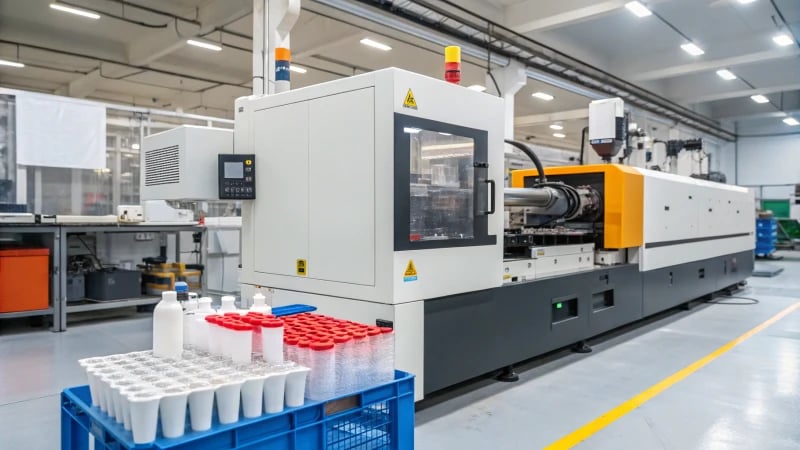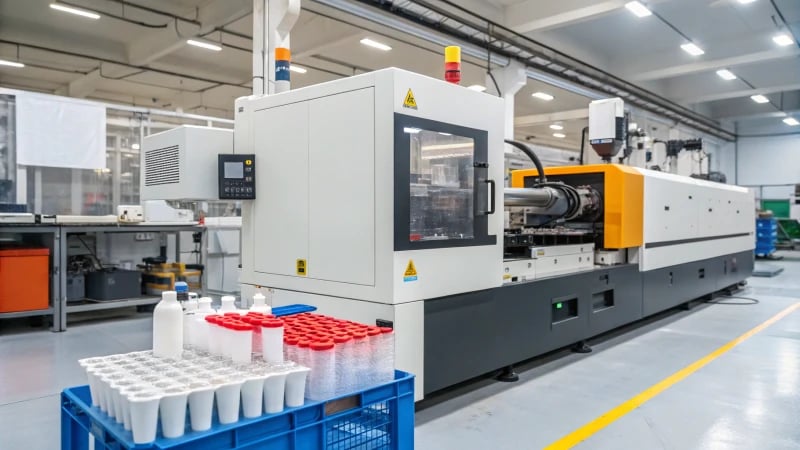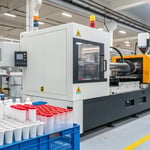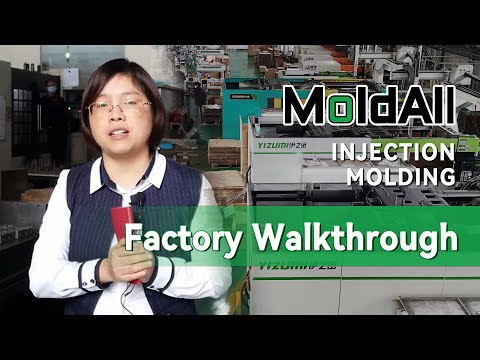
Do you ever think about how the gentle push needed to remove a molded plastic object could create or ruin it?
Ejection force influences plastic products by controlling their surface quality, accuracy and internal strength. Excessive force damages the product, leading to visible marks such as dents or cracks. Not enough force results in parts getting stuck. Molds suffer from too much force. This excess leads to more wear and a higher chance of components breaking. Long-term performance suffers as a result.
When I first discovered ejection force in my molding job, it felt like finding the missing puzzle piece. Too much force isn’t just a small problem. It can create visible marks on plastic surfaces, making them unsellable. Picture creating a smooth phone case and then seeing it ruined by ugly marks. Too little force causes the product to stick to the mold. This slows production.
Molds need to last long. Too much force does more than just push parts out; it wears down mold surfaces and even bends ejector pins. It’s like watching your favorite tool wear out too soon. The key is to find the right balance – enough force to release the product smoothly without damaging the mold. This balance is really important for both efficiency and quality in manufacturing. Then products and molds remain strong over time.
Excessive ejection force causes product deformation.True
Excessive force can lead to dents or deformations in plastic products.
Insufficient ejection force improves mold longevity.False
Insufficient force can cause incomplete demolding, not improve mold longevity.
What are the consequences of excessive ejection force?
Picture creating something beautiful, but small flaws ruin it. This happens with too much ejection force in molding.
Too much force during ejection causes problems in products. Surface scratches and size mistakes show up often. Mold parts wear out faster, too. This leads to expensive repairs.

Impact on Plastic Products
Excessive ejection force can cause a range of issues for plastic products:
-
Appearance Damage: Overly strong ejection forces can leave noticeable marks on product surfaces. These include dents, scratches, or even cracks. For instance, when producing luxury electronics cases, the force may penetrate the walls, leading to scrappage much like dropping your phone and scratching its cover.
-
Dimensional Accuracy Change: Excessive force may deform products, leading to inaccuracies that exceed tolerances. For example, in products with slender structures like thin plastic rods, excessive force can cause bending, affecting matching accuracy1 with other parts.
-
Internal Structure Damage: Products with fine internal structures, such as small ribs inside a product, may suffer from rib breakage or compartment rupture due to excessive force. This compromises both function and performance.
| Consequences | Examples |
|---|---|
| Appearance Damage | Dents, scratches |
| Dimensional Accuracy Change | Bending |
| Internal Structure Damage | Rib breakage |
Impact on Mold
Molds are not immune to the consequences of excessive ejection force:
-
Ejector Parts Damage: Components like ejector pins may bend or break if the force exceeds their design limits. For instance, I once heard a worrying noise during ejection – a bent ejector pin – which cost us time and money to repair.
-
Increased Mold Wear: Excessive force increases friction between ejector parts and the mold cavity over time, resulting in heightened wear. This affects dimensional accuracy and introduces metal debris into the plastic melt, affecting subsequent product quality.
| Consequences | Impact on Mold |
|---|---|
| Ejector Parts Damage | Bent/broken pins |
| Increased Mold Wear | Dimensional changes |
By understanding these impacts, designers can better anticipate and mitigate the negative effects of excessive ejection force. Learning from experiences shows how vital it is to balance force with care in all designs. Employing strategies to reduce ejection forces2 can optimize performance and minimize risks involved in the molding process.
Excessive force causes product surface cracks.True
Excessive ejection force can leave marks like cracks on plastic products.
Increased mold wear does not affect product quality.False
Increased wear introduces metal debris into the melt, affecting quality.
How does insufficient ejection force affect product quality?
Do small details often leave you confused about their impact on a product’s quality?
Insufficient ejection force in injection molding causes incomplete demoulding. This often leads to product deformations and higher scrap rates. Product appearance suffers and functionality reduces. Manual intervention becomes necessary. Production efficiency drops.

Understanding Ejection Force in Injection Molding
In my experience, adjusting the ejection force felt like solving a complex puzzle. I realized how important ejection force is in injection molding3. This force helps products come out of the mold smoothly without harm, much like carefully removing a cake from its tin. If the force is too weak, it can cause many problems that affect product quality.
The Consequences of Insufficient Ejection Force
-
Incomplete Demoulding:
I remember a time we faced incomplete demoulding with products having deep cavities. The ejection force was too low to overcome the hold of the mold, so parts stayed stuck. It stopped our production line, like a traffic jam, causing much waste and rework. -
Product Deformation:
Imagine trying to remove cookies with uneven spatulas; that’s what happens with uneven ejection force. It causes product deformation, where parts leave the mold in weird shapes due to stress. I’ve seen products come out twisted, like clay molded by an inexperienced potter.
Implications for Production Efficiency and Mold Integrity
Impact on Production:
| Issue | Consequence |
|---|---|
| Incomplete Demoulding | Requires manual intervention |
| Product Deformation | Increased product scrap |
We often had to step in or repeat ejection tasks and it felt like losing time. These troubles didn’t just lower efficiency but also increased labor costs and cycle time, causing frustration.
Impact on Molds:
Weak ejection force not only affects products but also harms molds. Frequent incomplete demoulding wears out mold parts, similar to how repeated use wears out a favorite pair of shoes.
Comparison with Excessive Ejection Force
Strong ejection force causes its own problems. Once, we saw severe damage on products due to this issue. Products got marks like scars and even had internal problems like cracks. Understanding these differences was crucial to improving our molding process4.
Finding the right ejection force felt like finding treasure – it improved product quality and lengthened mold life by reducing wear. This lesson is essential for anyone in molding and I’m eager to share it with other designers and engineers.
Insufficient ejection force leads to product deformation.True
Low ejection force causes uneven stress, deforming parts during mold release.
Excessive ejection force improves product quality.False
Too much force damages appearance and structure, reducing product integrity.
What Are the Long-Term Effects of Ejection Force on Molds?
Do you ever think about how the gentle push required in molding changes your product’s future?
Ejection force plays a crucial role in molding. It affects product quality and mold durability. Excessive force leads to surface damage. It causes structural changes and defects too. On the other hand, insufficient force results in incomplete demolding. It leads to deformation.

The Impact of Excessive Ejection Force
Picture a time when I discovered the dangers of too much ejection force. Late nights were spent on a new design for a client’s car interior. Everything seemed perfect. Then the first batch showed up with small ejection marks, clear signs of too much force used. These marks hurt the look and even caused cracks, which are unacceptable for high-quality products like automotive interiors5.
Additionally, excessive force altered the dimensional accuracy6 of the product. This excessive force bent delicate parts like plastic shafts—a real nightmare—compromising their compatibility with other components.
Internally, tiny but important parts like ribs broke under undue force meant to release them. And the molds? They suffered as well; ejector pins bent under pressure, disrupting everything.
| Problem Type | Affected Area | Example Impact |
|---|---|---|
| Appearance Damage | Product Surface | Cracks on automotive interiors |
| Dimensional Accuracy | Specific Structures | Bending in slender plastic shafts |
| Ejector Part Damage | Mold Components | Bent ejector pins disrupting mold cavity |
The Consequences of Inadequate Ejection Force
At times, the ejection force was too weak. The parts didn’t release fully—imagine a mold holding onto a part stubbornly. Production stopped, forcing us to remove parts by hand—a real pain! This showed that while patience is good, sometimes a stronger push is needed.
This weak force also brought more problems with shape; products looked uneven and strayed away from the precision I always wanted.
Mold efficiency can be compromised as well, with frequent incomplete demolding leading to increased mold repairs and maintenance costs—a costly hassle for everyone.
| Ejection Force Level | Product Effect | Mold Effect |
|---|---|---|
| Excessive | Surface damage, internal issues | Ejector part wear and tear |
| Inadequate | Incomplete demolding | Reduced efficiency, increased maintenance |
Balancing these forces proves crucial—not just surviving but thriving depends on it. Learning these dynamics helped me fine-tune molding processes for better outcomes. Now advanced tools assist in predicting and adjusting forces effectively to ensure product quality and extend mold lifespan.
Excessive ejection force causes mold damage.True
Excessive force can bend or break ejector parts, damaging molds.
Inadequate ejection force improves production efficiency.False
Inadequate force results in incomplete demolding, lowering efficiency.
How Can Ejection Force Be Optimized for Better Production?
Have you ever thought about how to find the right balance with ejection force in manufacturing? This concept truly transforms product quality and efficiency!
To improve ejection force, use balanced ejector pin placement. Keep the force even. Use modern servo systems. These actions probably reduce product damage. Production efficiency increases.

The Role of Ejection Force in Production
When I first entered the manufacturing field, I quickly saw how important ejection force is in the production process7. Imagine creating a masterpiece, only to ruin it in the final steps! Ejection force helps products leave molds safely without ugly defects.
Balancing Ejection Force
Finding the right ejection force is like perfecting a recipe. An optimal ejection force ensures the product is released without leaving marks or causing deformation. Too much force creates marks or cracks; too little and the product might not come out at all. Think of thin-walled plastic pieces; they are as delicate as a soufflé. I once saw a batch where excess force pierced product walls. Precision is very important.
| Issue | Impact on Product | Impact on Mold |
|---|---|---|
| Excessive Force | Appearance damage, dimensional inaccuracies | Ejector parts damage, increased wear |
| Insufficient Force | Incomplete demolding, deformation | Reduced production efficiency |
Strategies to Optimize Ejection Force
-
Adjusting Ejector Pin Distribution: Evenly spreading ejector pins is vital. It’s like setting up a tent – uneven pegs cause disaster. Consider using a CAD system8 for precise calculations.
-
Utilizing Servo Systems: Modern servo systems offer precise control over speed and force, much like changing the volume on a favorite playlist.
-
Regular Maintenance and Calibration: Regular check-ups keep us healthy, just as consistent maintenance helps equipment perform well, reducing wear and tear.
The Impact of Material Selection
Choosing the right material changes everything. Softer materials need less force but can deform easily. It’s like picking between velvet and silk for a dress – both lovely but needing different care.
Technological Innovations
Adopting innovative solutions like advanced simulation software really helps. Implementing innovative solutions9 such as predictive tools spot problems before they happen, making changes smoother.
Case Study: Optimizing Ejection in Complex Designs
I once worked on a project with tiny ribs and undercuts in intricate designs. Precise ejection force was crucial to protect internal structures. These strategies not only improved our production results but also improved operational success.
Using these methods has been very valuable in my experience. Optimizing ejection reduces defects and ensures manufacturing success overall.
Ejection force is crucial in injection molding.True
Ejection force ensures safe removal of products from molds, preventing damage.
Servo systems cannot control ejection force precisely.False
Servo systems offer precise control over ejection speed and force.
Conclusion
Ejection force significantly impacts plastic product quality and mold durability, with excessive force causing damage and insufficient force leading to incomplete demolding. Balancing is crucial for optimal manufacturing.
-
Understand why matching accuracy is crucial for components like plastic shafts to ensure proper assembly. ↩
-
Discover strategies to minimize ejection forces and improve mold performance and product quality. ↩
-
Learn about ejection force’s role in releasing molded parts, essential for understanding its impact on product quality. ↩
-
Explore techniques for balancing ejection force to enhance product quality and mold longevity. ↩
-
Learn how excessive ejection force affects the visual quality of molded products. ↩
-
Discover how ejection force impacts the dimensional precision of molded products. ↩
-
Understanding the role of ejection force is vital for achieving efficient production without product defects. ↩
-
Discover how CAD systems can enhance precision in ejector pin placement for balanced force application. ↩
-
Explore cutting-edge technologies that help predict and adjust ejection forces efficiently. ↩






